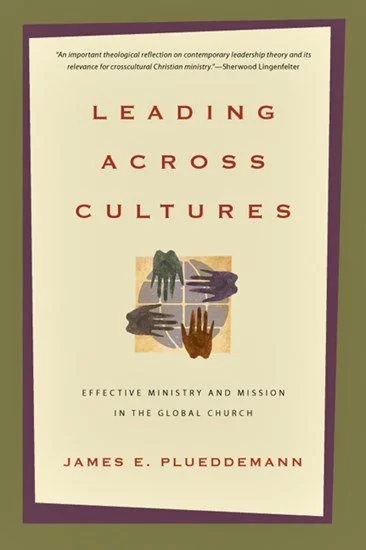By James E. Plueddemann
The thought of working cross-culturally is exciting, but the best intentions fail when leaders ignore the what and how of leading across cultures. James Plueddemann helps remedy that problem.
About the author:
Jim Plueddemann (Ph.D. Michigan State), served for many years with Serving In Missions (SIM) both as missionary and later, for ten years, as director. At home on the field or in the classroom, he also served as Professor of Missions and chaired the Department of Missions and Evangelism (now Intercultural Studies) at Trinity Evangelical Divinity School. Jim and Carol Plueddemann have co-written several books.
The book in a sentence (or two):
Christians from every nation are interacting cross-culturally more than ever. This creates rich opportunities for Kingdom collaboration, but also enhances global tensions when culturally diverse leadership values and styles clash. This book is a primer on how leaders foster mutual understanding, cooperation, and enhanced ministry to work together more effectively.
My quick take on Leading Across Cultures:
This book grew on me page by page, chapter by chapter. I started to write it off as rather basic. Happily, I kept going. Jim’s cross-cultural experience coupled with his careful biblical thought, helped to further refine my understanding of leadership and how to function more effectively in cross-cultural settings. Leading Across Cultures is a solid reference for leaders who want to improve, and an essential for leaders who want to engage other cultures more effectively at home or abroad.
Overview and Analysis:
Plueddemann will fool you. His rich storehouse of stories coupled with practical application might bring charges of a “soft work.” Don’t fall for that. This is praxis on display. As one has said, “The person who knows it best explains it most clearly.” The author defines his terms (e.g. missionary, leadership, evangelism). He delivers a holistic perspective as you can see from the four parts of this book:
Part I: Multicultural Leadership in the Worldwide Church gives us the author’s own story coupled with his model of Cross-Cultural Leadership.
Part 2: Leadership and Culture takes the reader on a deep dive, examining the research describing the impact of culture on leadership values. The author examines leadership and culture theologically, contextually (communication, time, church, leadership), from the perspective of power, and from the perspective of individualism. This portion was thorough.
Part 3: Contextualizing Leadership "deals with the problem of how universal biblical truth intersects with diverse cultural values" (149).
Part 4: Global Leadership Practice "applies insights from the Bible and culture to practical issues in world mission and the global church" (186).
I appreciate his holistic view of missions (Figure coming), but also the unapologetic view that “Evangelism is inviting people to come to Jesus, sharing the good news ‘that Christ died for our sins according to the Scriptures, that he was buried, that he was raised on the third day according to the Scriptures’ (1 Cor 15:3-4). . . the clear proclamation of the gospel is at the very heart of missions” (52).
My Takeaways:
1. Be a learner: You can’t read this book without seeing Plueddemann’s posture as a learner. We see this as he shares his own experiences and relays the words and experiences of others: “Choosing to be learners is what helps us most to understand different perspectives on leadership. Cross-cultural leadership is a school from which you never graduate… it is not about my success, but about walking with and helping others succeed, whatever their cultural peculiarities may be and whatever their callings are." Dr. Joshua Bogunjoko, Deputy International Director for SIM (29).
2. Invest in your team: Plueddemann emphasizes the leader’s role in envisioning a better future and the importance of investing in his/her team to catch and grow in that vision.
3. The Scope of Missions – A holistic missional overview:
See page 50 for an illustration of how the author sees missions fitting together.
4. Historical acumen: Plueddemann gave me a more complete historical picture of the concept of a self-functioning church, highlighting Rufus Anderson and Henry Venn who proposed (150 years ago) that mature churches are characterized as self-propagating, self-supporting, and self-governing (55). Paul Hiebert added, self-theologizing, applying Scripture to one’s cultural situation.
5. Multicultural competence: His suggestions for multicultural leadership competence:
(1) Assess and acknowledge my own underlying cultural assumptions/biases about leadership.
(2) The Scriptures provide a multitude of leadership examples; which are principles of leadership for every culture (note: we usually see biblical principles through the eyeglasses of our culture). Cultural values relating to leadership are subconscious assumptions about how people think about power, handle ambiguity, prize individuality, achieve status or plan for the future (70-71).
(3) The greatest tensions in multicultural leadership arise from tension that grow out of internal (hidden) values.
(4) “Globalization means that people are looking more and more alike on the outside, but the inner layer of cultural values hasn’t changed very much” (73).
6. Differentiating leadership paradigms (which are often shaped by culture):
(1) Low context (factory paradigm): mechanistic leaders who manage by objectives
(2) High context (wildflower paradigm): existential leaders who manage by interruption.
(3) Theology/Vision Driven: Pilgrim metaphor: “It is a vision for what people might look like if they would enroll as lifelong students in Jesus’ school of discipleship, consistently displaying the fruit of the Spirit (190). The Pilgrim metaphor helps bridge the strengths of both low-context and high-context cultures while minimizing the differences between the two.
7. Vision: “Vision describes a picture of the kingdom of God on earth and in heaven. The outcome of vision is transformed lives, demonstrating God’s love in individuals and the church (192).
Don’t let vision get replaced by strategy. It may not be intentional, but it happens. When we do we elevate the strategy used to accomplish the vision (e.g. sharing resources) over the vision (e.g. equipping leaders to equip churches) (193).
Visionaries need realists: Don Quixote is an unrealistic visionary, forever embarking on a quest to save the world from evil. Sancho Panza is the realist who reminds Don Quixote that he needs a horse and that the giants he sees are really windmills. Quixote has his head in the clouds, while Panza has his feet on the ground. Realists need visionaries, and visionaries need realists who understand the current needs, opportunities and resources of the situation (194).
8. His discussion on high-power-distance/low-power-distance (chapter 12). As he notes, this is a theological and practical paradox. I thought his biblical analysis on this point was well-examined. You can find both examples in Scripture. Two points:
First, “The progress of revelation between the Old and New Testaments indicates a shift from higher to lower power-distance values” (102).
Second, “Scripture seems to leave room for some flexibility regarding power distance in leadership style but not in leadership attitudes” (102).
This was a helpful summary statement: In light of the cultural variety and implications, “frank discussions about power distance need to take place at the beginning of the partnership relationship” on matters of leadership, collaboration, resources, decision-making and ownership (104).
9. Strategy: Leaders must be more than visionaries. They are called to take bold, creative action to fulfill their vision. “Strategy grows out of vision and an understanding of the situation. Strategies are like steppingstones across the river, and the vision is represented by the far shore. By faith, we see short term goals that can be used of God to accomplish the vision” (190).
10. Leadership Cultural Bias: A leader cannot assume his or her cultural leadership perspective is shared or even valued by other cultures. A leader must be a learner, culturally humble, and willing to learn – desiring to learn – what leadership looks like as well as what is valued in a different context.
In a single African country, we find three substantially different cultural assumptions about leadership development. Leadership development in these three cultures took place though loyalty to a patron (Hausa), individual effort (Igbo) and royal lineage (Yoruba). Few of the American assumptions about leadership would be culturally appropriate in traditional Nigeria. It would be absurd to expect that a foreign “expert” could teach a leadership course in Nigeria without an understanding of the traditional cultural assumptions about how leaders are developed (203).
How to broaden cross-cultural perspectivism: How can egocentric and family-centric leaders move toward seeing the world from an ever-broadening perspective? Most studies show that perspective transformation is not learned through courses on theories of leadership or elaborate management techniques. Perspective transformation develops by reflecting on disequilibrating experiences and through disorienting dilemmas (205). This was the way God grew Moses.
The author piqued my curiosity about these books:
Don Quixote by Miguel de Cervantes. I have yet to read this classic. Plueddemann’s use of him in his discussion of vision and strategy, helped to ensure that I will.
Words to ponder:
1. Costly Grace: “Costly grace [is] turned into cheap grace without discipleship.” Dietrich Bonhoeffer, The Cost of Discipleship (New York: Macmillan, 1963, 53).
2. Leader: A person who “motivates people to work collaboratively to accomplish great things” (Amanda Ruggeri, “America’s Best Leaders: How They Were Picked,” U.S. News & World Report, December 8, 2008, 55).
3. Power: In areas that do not contradict Scripture, the bi-cultural leader will follow the admonition of the apostle Paul: “I have become all things to all people so that by all possible means I might save some” (1 Corinthians 9:22, 108).
4. Vision: “We seek vision on our knees” (192).
5. Perspective: “One of the primary tasks of leadership development is to help people to think bigger, to broaden their horizons, and to enlarge their perspectives. I am convinced that the most effective leaders are those who have the broadest perspectives” (204).
6. Leaders are life-long learners: Cross-cultural leadership is a school from which you ever graduate…
7. Leadership and Discipleship: “Good leaders are fervent disciples of Jesus Christ, gifted by the Holy Spirit, with a passion to bring glory to God. They use their gift of leadership by taking initiative to focus, harmonize, and enhance the gifts of others for the sake of developing people and cultivating the kingdom of God” (16).
8. Cultural awareness: “I have learned that there are not superior or inferior cultures or cultural approaches to leadership; there are only different approaches.” Joshua Bogunjoko, Deputy International Director for SIM (30).
9. Conflicting Cultural Values: Cultural values of individualism versus collectivism most often lie hidden below the surface yet have a significant visible impact for cross-cultural teams (23).
10. Discouragement: “I steadfastly refuse to gratify the Devil by becoming discouraged.” Ian Hay, former general director of SIM (41).
11. Evangelism: Ministering to peoples’ need is both an end and a means [in evangelism] (51).
Conclusion:
I highly recommend Leading Across Cultures by Jim Plueddemann. As to emotional intelligence, his perspectives on cross-cultural leadership will help leader’s EI quotient increase. As to theology, he separates culture from theology, thus reducing cultural arrogance, and the foolish mistake of assuming one’s cultural perspective is God’s perspective. As to leadership paradigm, his treatment of the Pilgrim Leader Paradigm was highly insightful and theologically astute.


